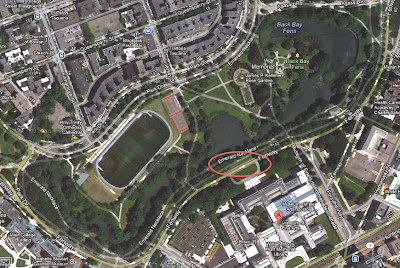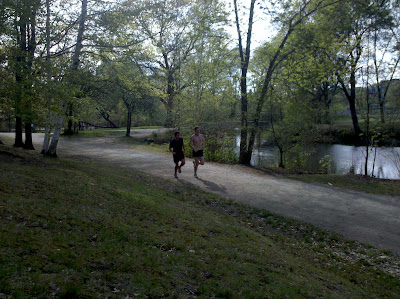This post will discuss the dual paths for pedestrians and bicyclists along the Back Bay Fens near the Boston Museum of Fine Arts.
Google Maps Link to MFA (see Emerald Necklace path next to the Fenway)
Below is a map view of the Fens with an indication of where most of these pictures were taken.
 |
| Back Bay Fens (circled area indicates where photographs were taken). |
I will discuss the intended use, actual use, and then provide reasons and recommendations.
Intended Use
The intended use for the dual paths is for pedestrians to use the walking path and bicyclists to use the bike path. This separation makes the use of the paths more comfortable and efficient for both groups.
 |
| Intended use: pedestrians on walking path, bicyclist on bike path. |
Actual Use
It is unclear which path is for pedestrians and which path is for bicyclists. There are pedestrians and bicyclists using both paths. There are more pedestrians than bicyclists, but neither group showed a preference for either path. Below are photographs that show bicyclists using the lower path (farthest from street), and a few moments later, runners using the same path.
 |
| Bicyclists using lower path. |
 |
| Runners using lower path. |
The next two photographs show bicycles and pedestrians sharing the same path. The second photograph was taken further up along the Fenway where the upper path is made of concrete, yet there is still path sharing.
 |
| Bicyclist and runner using lower path. |
 |
| Walkers and bicyclist using upper path |
I also observed that some of the bicyclists seemed to be casual bicyclists riding for pleasure, as opposed to biking simply to reach a destination (see below).
 |
| Casual bicyclists on lower path. |
 |
| Casual bicyclists on upper path. |
Clearly the Fens is an attractive spot to go for a bike ride, and having a bike path separated from pedestrians might make it even more pleasant for bicyclists.
In addition, I observed some bicyclists who had chosen to ride on the Fenway. These bicyclists looked to be traveling somewhere, as opposed to riding for pleasure (see below).
 |
| Bicyclist traveling on the Fenway in front of the MFA. |
 |
| Bicyclist traveling on the Fenway. |
If the upper path were designated for bikes, it is possible that some bicyclists might choose to use that path rather than fight with cars in the street.
Reasons for Intended Use vs. Actual Use Disparity
The two paths are hardly distinguishable. They are both crushed stone paths of equal width. The only difference between the two paths is that the path closest to the street has edging on each side of the path. This led me to conclude that the upper path is for bicycles since the edging would be useful for bicycles while pedestrians would prefer no edge. It also makes sense for the bicycle path to be closest to the street, putting pedestrians farther from traffic and closer to the park.
 |
| Bike path with edge. |
 |
| Pedestrian path with no edge. |
Further adding to the problem of path distinction, there are no signs identifying which path is for pedestrians and which path is for bicyclists. Given the similarity between paths and the lack of signage indicating what type of path each is meant to be, it is no wonder that pedestrians and bicyclists use both paths.
As mentioned above, not all of the upper path is made of crushed stone. Here is the section where the upper path changes from concrete to crushed stone.
 |
| Concrete in foreground, crushed stone in background. |
As for the reasons why there is an inconsistency in path material and a lack of signage, I do not know. I called the Emerald Necklace Conservancy, who told me to contact the Department of Conservation and Recreation (DCR). I played phone tag with the DCR, but never reached anyone who could comment.
Update: Someone from the DCR got back to me and said that they put in the stone dust path with granite edging near the MFA about two years ago. He said that he was not aware of any intention for it to be a bike path, and that paths in Boston are generally shared-use paths. As for the path closer to the park, he said that land farther than 25 feet from the road is the property of the City of Boston Parks & Recreation Department, not the DCR.
Recommendations
In order to create a less stressful environment by keep bicyclists separate from pedestrians, there should be signs that indicate separated paths (such as the one shown below).
 |
| Sign indicating separate bike and pedestrian paths. |
Another solution would be to install asphalt or concrete in the section where the upper path is made of crushed stone and to then paint bicycle markings. However, this solution would be more expensive than signs, and would take the upper path out of commission for some time. Therefore, installing signs would be the cheapest, least intrusive way to keep bicycles and pedestrians separate.
No comments:
Post a Comment